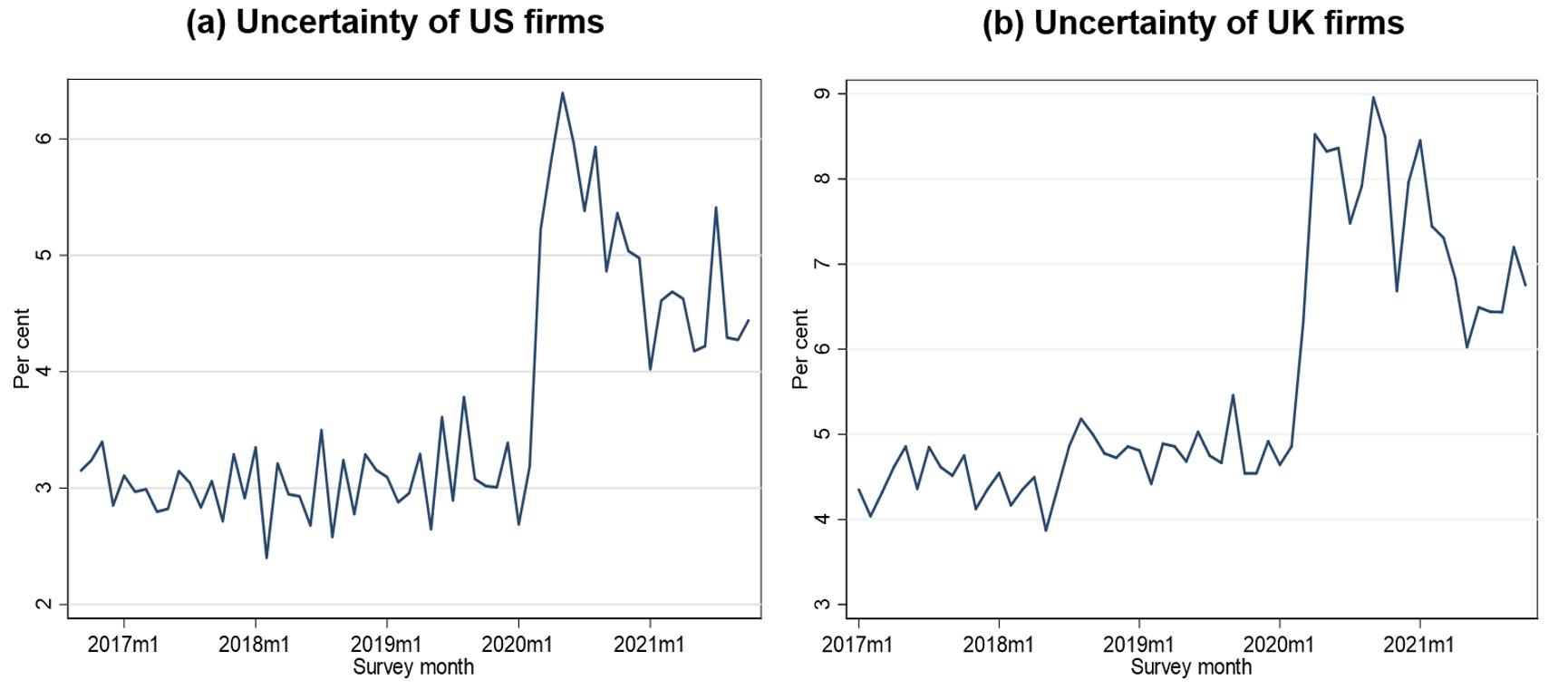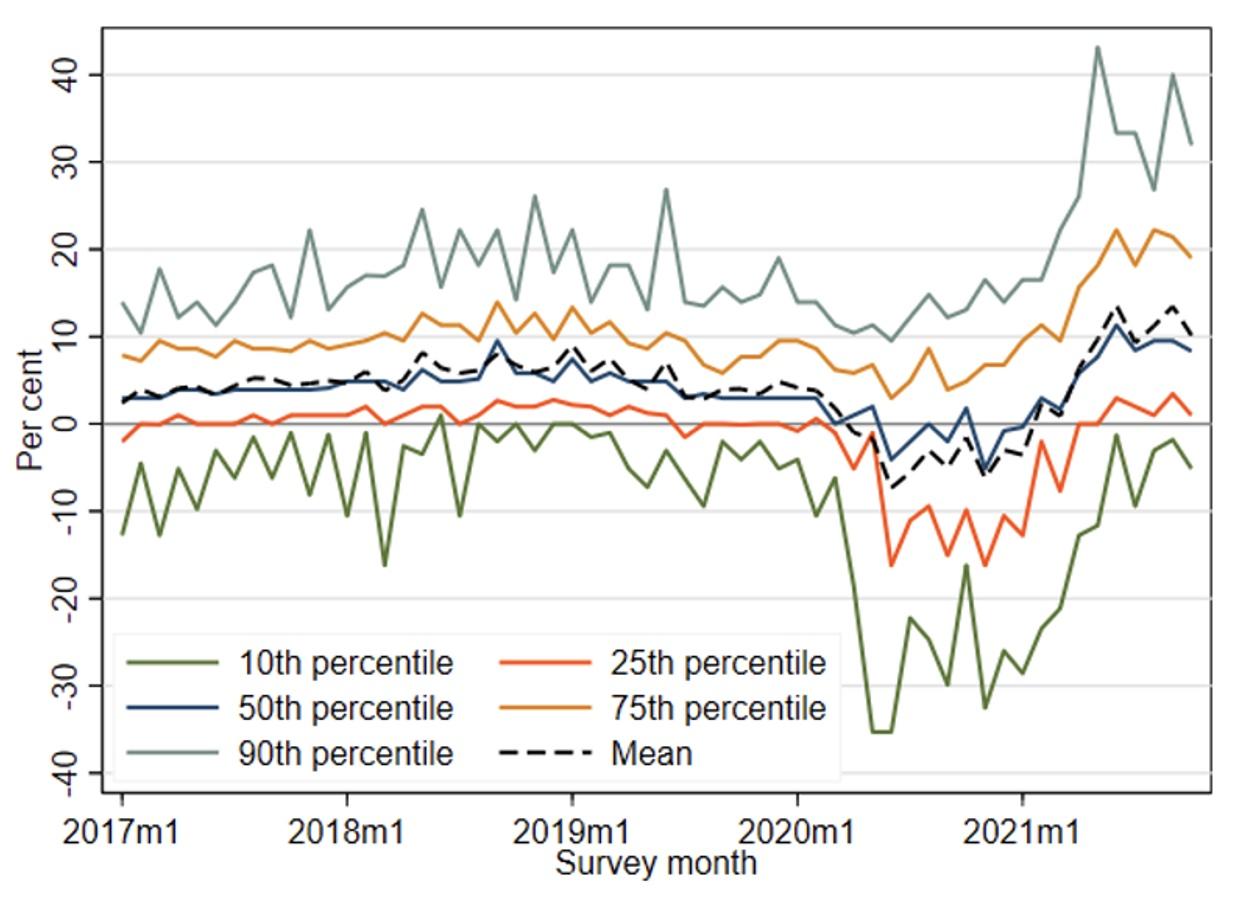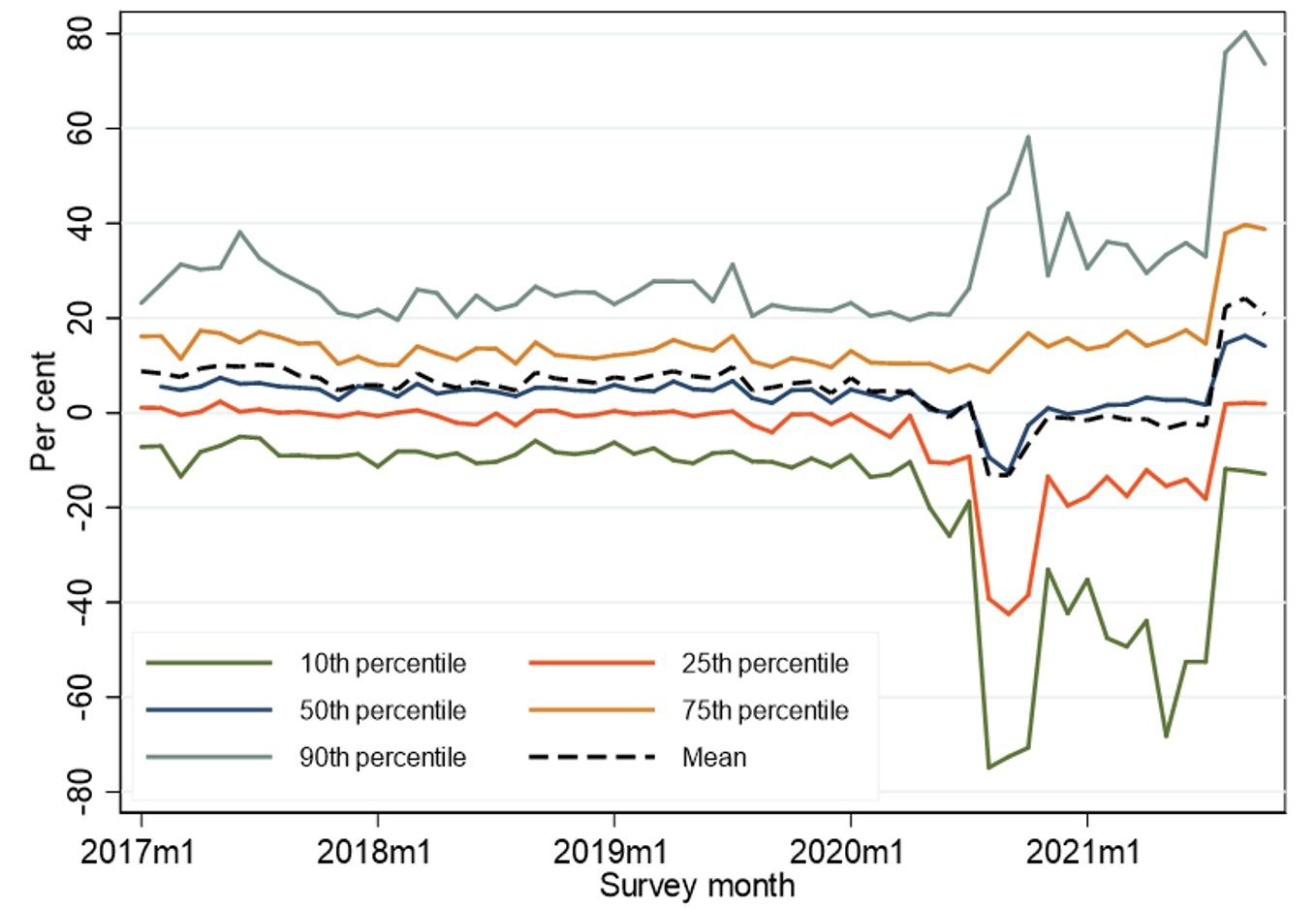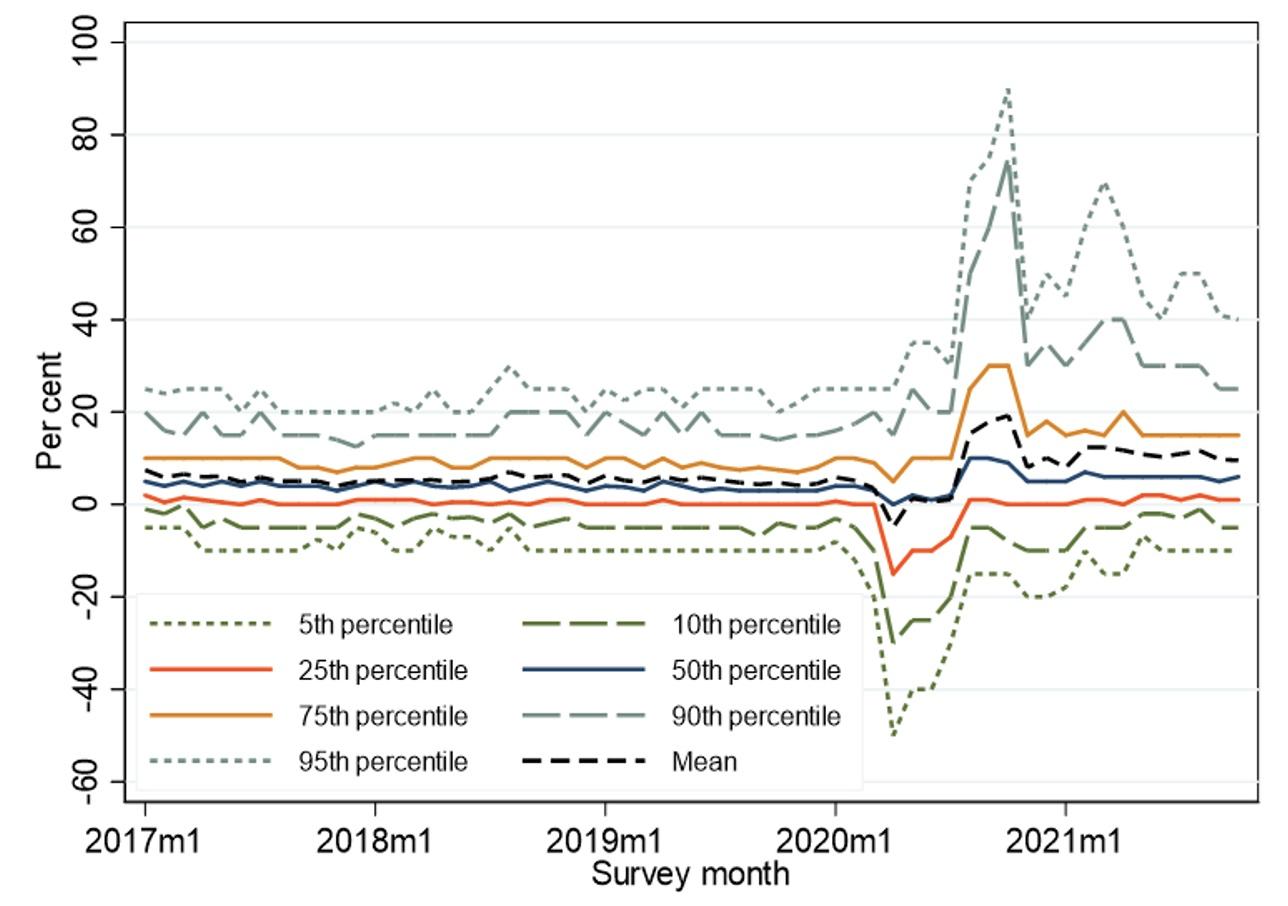The onset of the COVID-19 pandemic triggered a massive spike in uncertainty (Baker et al. 2020) and a large increase in job reallocation (Anayi et al. 2021). Uncertainty eased coming out of the crisis in spring 2020, but it remained elevated relative to pre-COVID levels as measured by surveys of business leaders in the US and UK (Altig et al. 2020a, 2020b). Moreover, the nature of firm-level uncertainty has shifted markedly since the early months of the pandemic, from an enormous widening in perceived downside risk to a sharp increase in upside risk. In short, business executives went from worrying about how bad COVID might get to wondering about how strongly they might bounce back.
We run two panel surveys that elicit firm-level growth forecasts from business executives. The Survey of Business Uncertainty, fielded by the Atlanta Federal Reserve Bank in cooperation with the University of Chicago and Stanford University, yields responses for about 500 firms per month in the US. The Decision Maker Panel – run by the Bank of England, University of Nottingham, and Stanford University – yields responses for about 3,000 firms per month in the UK. The vast majority of respondents are CEOs, CFOs, business owners or serve in other senior management roles. The brevity of our survey instrument and the involvement of central banks and leading universities help generate high response rates of about 60% for regular panel members.
Each month, the surveys ask executives about sales growth at their firms over the past year and for sales forecasts over the next year. Importantly, the forecast questions ask about the lowest, low, medium, high and highest sales growth scenarios and the probabilities of each scenario. Thus, for each firm, the surveys yield a 5-point subjective forecast distribution of sales growth rates over the next year.
Firm-level uncertainty and how it evolves after the COVID-19 shock
Using the survey responses, we measure a firm’s subjective uncertainty as the standard deviation of its forecast distribution over its own sales growth rate. We then compute the activity-weighted mean of subjective uncertainty across firms by month. Figure 1 shows the resulting (average) subjective uncertainty measure, which quantifies the perceived level of uncertainty about firm-level sales growth outlooks over the next year.
Figure 1 Subjective uncertainty about firm-level sales growth rates over the next four quarters
Notes: Subjective uncertainty about the growth rate of sales at a four-quarter look-ahead horizon. US and UK data through October 2021. See Altig et al (2020a) for more details. Data available at www.atlantafed.org/research/surveys/business-uncertainty and www.decisionmakerpanel.com.
In Altig et al. (2020a, 2020b), we discuss the evolution of these and other uncertainty measures in the early wake of the pandemic. Here, we consider how firm-level uncertainty has evolved as the US, UK, and global economies have recovered. Recent columns by Coibion et al. (2021) and den Haan et al. (2021) discuss the potential implications of economic uncertainty for household spending and the labour market.
The COVID-19 shock pushed average uncertainty among US firms from about 3% before the pandemic to 6.4% in May 2021. Uncertainty fell back to about 4.5% in October 2021. Data for UK firms tell a similar story: firm-level uncertainty rose from about 4.9% before the pandemic to 8.5% in April 2021 and has since declined to about 6.8%.
Pre-pandemic uncertainty is higher in the UK for two reasons. First, the Brexit process elevated UK uncertainty (Bloom et al. 2019). Second, UK firms tend to be smaller, and smaller firms are typically more uncertain about future growth (Altig et al. 2020c).
A tale of two tails
We now consider the cross-firm distribution of realised sales growth rates and the cross-firm average subjective forecast distribution. These statistics throw new light on the nature of the COVID-19 shock, COVID-19-induced economic uncertainty, and how uncertainty has changed over time.
The US distribution of realised growth rates widened greatly in the wake of the pandemic, as shown in Figure 2, panel (a). Initially, the widening occurred mostly in the lower half of the distribution. For example, the 10th percentile of realised growth rates fell from about -5% in late 2019 to a trough of -35% in May 2020. The 25th percentile shows the same pattern in somewhat muted form.
In contrast, growth rates at the 75th and 90th percentiles fell by about 3 percentage points from late 2019 to May 2020. By the summer of 2021, however, the lower tail of the realised growth rate distribution had recovered to pre-pandemic values, while growth rates at the 75th and 90th percentiles had greatly surpassed their pre-pandemic values.
Figure 2 US distributions of past and future firm-level sales growth rates
a) Realised growth rates
Notes: Calculated using monthly data through October 2021. This is a plot of the activity-weighted distribution of firm-level sales growth rates over the past year.
b) Forecast distribution of growth rates
Notes: Calculated using monthly data through October 2021. This is a plot of the subjective distribution for the representative firm’s future sales growth rates over a 4-quarter look-ahead horizon. To calculate this distribution, we pool over all firm-level subjective forecast distributions in the indicated month and weight each firm by its activity level. Then we use the probabilities assigned to each possible future sales growth rate to obtain activity-weighted quantiles of the future sales growth rate distribution.
Source: Survey of Business Uncertainty at www.atlantafed.org/research/surveys/business-uncertainty
The average subjective forecast distribution over firm-level growth rates in the year ahead shows a similar pattern, as seen in panel b of Figure 2. To calculate this distribution, we pool all firm-level subjective forecast distributions in a given month and weight each firm by its activity level. The figure thus captures both average uncertainty in sales growth-rate forecasts at the firm level and whether that uncertainty is mainly to the upside, mainly to the downside, or evenly balanced between the two.
When the pandemic took hold in March 2020, firms perceived a large increase in downside uncertainty, placing much greater weight on the possibility of highly negative growth rates. While the 90th and 75th percentiles of the forecast distribution changed little, the median fell by about 5 percentage points and the 25th and 10th percentiles fell by 20 and 40 percentage points, respectively. In short, the average firm saw dramatically more downside risk in year-ahead sales growth rates during the early months of the pandemic.
As the pandemic continued, downside risks abated greatly. By early 2021, the forecast distribution remained highly dispersed (i.e. subjective uncertainty remained high), but it increasingly reflected upside rather than downside risk. In recent months, firm-level subjective uncertainty is mainly about prospects for rapid sales growth over the coming year and only secondarily about the possibility of sharp contractions.
Data for UK firms tell a similar story, as shown in Figure 3. The lower tail in the distribution of realised sales growth rates fell tremendously by the second quarter of 2020 in reaction to the pandemic and national lockdown (panel a). It fell again after the second national lockdown in early 2021. UK firms also perceived huge downside risk at the outset of the pandemic, as evidenced by the large downward shift in the lower tail of the forecast distribution (panel b).
As the economy began to recover, perceived uncertainty shifted from the lower tail to the upper tail. That is, firms placed less weight on the possibility of dramatic declines and more weight on the possibility of rapid growth. By summer 2021, downside uncertainty among UK firms had returned to pre-pandemic levels. Upside uncertainty remains highly elevated.
Figure 3 UK distributions of past and future firm-level sales growth rates
a) Realised growth rates
Notes: Calculated using monthly data through October 2021. The results are based on the question: ‘Looking back over the year from first/second/third/fourth quarter of this year, by what % amount has your sales revenue changed since the same quarter a year ago?’ Monthly data collected between May and July refer to Q1 of that year, data collected between August and October refer to Q2, data collected between November and the following January refer to Q3 and data collected between February and April refer to Q4 of the previous year.
b) Forecast distribution of growth rates
Notes: Calculated using monthly data through October 2021. The results are based on the question: ‘Looking a year ahead from the first/second/third/fourth quarter of this year to the first/second/third/fourth quarter of next year, by what percentage do you expect your sales revenue to have changed in each of the following scenarios: lowest, low, middle, high and highest?’ Respondents were then asked to assign a probability to each scenario. The five scenarios for each firm in the survey are pooled together and weighted by the probability attached to them and firm size to generate the overall distribution. Monthly data collected between May and July refer to Q1 of that year, data collected between August and October refer to Q2, data collected between November and the following January refer to Q3 and data collected between February and April refer to Q4 of the previous year.
Source: Decision Maker Panel at decisionmakerpanel.co.uk
Statistically, we can characterise the story for the US and the UK as follows: the early months of the pandemic involved a negative first-moment shock, a positive second-moment shock, and a negative third-moment or skewness shock. That is, the pandemic drove a large drop in the first moment of the economic outlook and much higher uncertainty in the form of highly elevated downside risks. While the pandemic recession unfolded with unusual speed and severity, this cross-moment pattern is consistent with previous recessions, which often combine a negative mean, positive uncertainty, and negative skewness shock to sales growth rates (Salgado et al. 2020).
The rapid rebound from the pandemic recession and strong reversal in the skewness effect is less typical. It is absent, for example, in cyclical episodes that feature protracted downturns and slow recoveries, as in the Great Recession and its aftermath.
In independent work, Fiori and Scoccianti (2021) tap the Bank of Italy’s Survey of Industry and Service Firms to measure subjective uncertainty about own-firm sales growth. The survey of Italian firms takes place annually, which makes it harder to assess the precise timing of developments. Like us, however, Fiori and Scoccianti find that subjective uncertainty rose dramatically in 2020 in reaction to the COVID-19 shock and fell back somewhat from 2020 to 2021. They also find that the nature of uncertainty shifted from downside risk initially in reaction to the pandemic to upside risk by 2021. Thus, at least three of the world’s major economies underwent a dramatic shift in the nature of firm-level uncertainty as the pandemic unfolded.
The shifting nature of firm-level uncertainty may bode well for economic recovery, given that several theoretical analyses highlight the potential for downside uncertainty to have more powerful negative effects on economic activity than upside uncertainty. See, for example, Bernanke (1983), Hansen et al. (1999), Ilut and Schneider (2014), and Alfaro et al. (2018).
Looking ahead, uncertainty may revert to pre-pandemic levels in the US and UK, as COVID-19 case numbers and deaths fall in both countries, social distancing subsides, and policy stimulus fades out on both sides of the Atlantic. Many firms see tantalising possibilities to the upside, according to our data. Nevertheless, there are significant risks to recovery from ongoing supply-chain disruptions, inflationary pressures, low vaccination rates in many countries, and the potential for new SARS-CoV-2 variants (Brilliant et al. 2021).
References
Alfaro, L, N Bloom and X Lin (2018), “The finance-uncertainty multiplier”, NBER Working Paper 24571.
Altig, D, S Baker, J M Barrero, N Bloom, P Bunn, S Chen, S J Davis, J Leather, B H Meyer, E Mihaylov, P Mizen, N Parker, T Renault, P Smietanka and G Thwaites (2020a), “Economic uncertainty before and during the COVID-19 pandemic”, Journal of Public Economics 191, article 104274.
Altig, D, S Baker, J M Barrero, N Bloom, P Bunn, S Chen, S J Davis, J Leather, B H Meyer, E Mihaylov, P Mizen, N Parker, T Renault, P Smietanka and G Thwaites (2020b), “Economic uncertainty in the wake of the COVID-19 pandemic”, VoxEU.org, 24 July.
Altig, D, J M Barrero, N Bloom, S J Davis, M Bryan, B H Meyer and N Parker (2020c), “Surveying business uncertainty”, Journal of Econometrics, in press.
Anayi, L, J M Barrero, N Bloom, P Bunn, S J Davis, J Leather, B Meyer, M Oikonomou, E Mihaylov, P Mizen and G Thwaites (2021), “Labour market reallocation in the wake of Covid-19”, VoxEU.org, 13 August.
Baker, S, N Bloom, S J Davis and S J Terry (2020), “COVID-Induced Economic Uncertainty” NBER Working Paper No. 26983.
Bernanke, B S (1983), “Irreversibility, uncertainty, and cyclical investment”, Quarterly Journal of Economics 98(1): 85–106.
Bloom, N, P Bunn, S Chen, P Mizen, P Smietanka and G Thwaites (2019), “The impact of Brexit on UK firms”, NBER Working Paper 26218.
Brilliant, L, L Danzig, K Oppenheimer, A Mondal, R Bright and W I Lipkin (2021), “The forever virus: A strategy for the long fight against COVID-19”, Foreign Affairs 76.
Coibion, O, D Georgarakos, Y Gorodnichenko, G Kenny and M Weber (2021), “The effect of macroeconomic uncertainty on household spending”, VoxEU.org, 31 July.
den Haan, W, L Freund and P Rendahl (2021), “Wait and see: The labour market implications of economic uncertainty”, VoxEU.org, 11 September.
Fiori, G, and F Scoccianti (2021), “The economic effects of firm-level uncertainty: Evidence using subjective expectations”, Board of Governors of the Federal Reserve System, International Finance Discussion Papers No. 130.
Hansen, L P, T J Sargent and T D Tallarini (1999), “Robust permanent income and pricing”, Review of Economic Studies 66(4): 873–907.
Ilut, C, and M Schneider (2014), “Ambiguous business cycles”, American Economic Review 104(8): 2368–99.
Salgado, S, F Guvenen and N Bloom (2020), “COVID-19: The skewness of the shock”, VoxEU.org, 5 May.


















